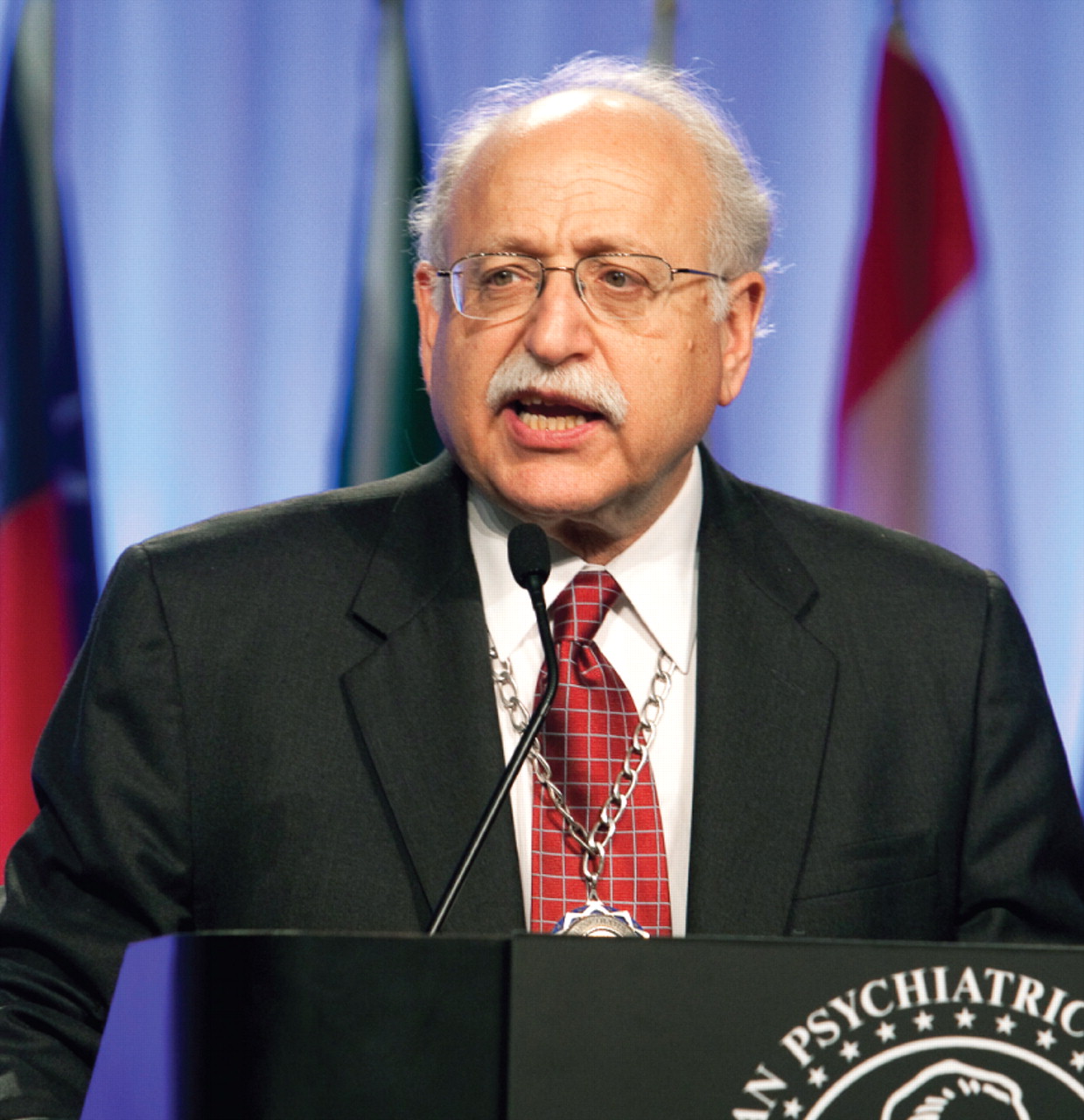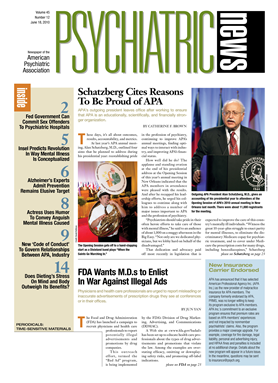These days, it's all about outcomes, results, accountability, and metrics.
At last year's APA annual meeting, Alan Schatzberg, M.D., outlined four aims that he planned to address during his presidential year: reestablishing pride in the profession of psychiatry, continuing to improve APA's annual meetings, finding optimal ways to interact with industry, and improving APA's financial status.
How well did he do? The applause and standing ovation at the end of his presidential address at the Opening Session of this year's annual meeting in New Orleans indicated that the APA members in attendance were pleased with the results. And after he recapped his leadership efforts, he urged his colleagues to continue along with him to address a number of major issues important to APA and the profession of psychiatry.
“Psychiatrists should take pride in their often heroic efforts to take care of those with mental illness,” he said to an audience of about 1,000 on a muggy afternoon in the Big Easy. “Not only are we dedicated physicians, but we lobby hard on behalf of the disadvantaged.”
That dedication and advocacy paid off most recently in legislation that is expected to improve the care of this country's mentally ill individuals. “Witness the great 10-year-plus struggle to enact parity for mental illnesses, to eliminate the discriminatory Medicare copay for psychiatric treatment, and to cover under Medicare the prescription costs for many drugs, including benzodiazepines,” Schatzberg said. Topping off these achievements was the passage of health care reform.
Regarding his aim to restore pride in the profession, Schatzberg noted that APA members have much to be proud of: APA's annual meetings, which showcase the great progress that has been made in the neurosciences; the American Psychiatric Foundation (APF), which supports numerous educational and community initiatives and even an Emmy-nominated TV show, “Healthy Minds” (see
‘Healthy Minds’ TV Show Earns Emmy Nominations); the American Psychiatric Institute for Research and Education (APIRE), which has made contributions in many areas of psychiatry; the development of
DSM-5; and the outstanding journals, books, and newspaper produced under American Psychiatric Publishing Inc. (APPI).
Among these, DSM-5 had the highest public profile this past year. A Web site containing the proposed diagnostic criteria for DSM-5 was launched in February and invited feedback from psychiatrists, other physicians, mental health professionals, and the public. “The Web site generated 41 million hits and over 8,700 substantive comments—truly remarkable and a great example of transparency,” Schatzberg observed.
Nonetheless, there have been attacks on DSM-5 that reflect many misperceptions that psychiatry needs to combat. The first involves overdiagnosis and inappropriate diagnosis. Schatzberg countered, “Psychiatric disorders are unfortunately common, independent of the number of psychiatrists. In fact, we have a major shortage of psychiatrists in this country. Psychiatrists do not need to look for business.”
Second, stigmatization is still very real. For example, critics have attacked the proposed diagnosis of mild neurocognitive impairment. “Are the same critics attacking the neurologists for their [diagnosis of] proposed mild cognitive impairment? No. This hypocrisy really reflects stigmatization.”
Schatzberg noted that some of the criticisms have come from English and history professors, which suggests to him a different kind of problem. The general public, for example, read pop psychology articles or watch pop psychologists on TV and think they know a lot about emotions and feelings. Adding to this false sense of understanding is the common language used in psychiatric nosology.
“Other medical specialties have disorders based on Latin and Greek terms that are complemented by lay terminology or descriptors—take, for example, myocardial infarction and heart attack. When you look at psychiatry, you see disorders that are distinctly unmedical in sound in many ways—binge-eating disorder, major depression, panic disorder, etc., with no real parallel and more technical medical terminology.... We need to be more medical to be taken more seriously.”
Education, Industry Relations Addressed
Regarding his aim to improve APA's annual meetings, he observed that APA's fall 2009 Institute on Psychiatric Services had the highest attendance ever and enjoyed rave reviews, and for this year's annual meeting, experts were engaged to serve as consultants to the Scientific Program Committee and help evaluate submissions. The result was a “dynamite program with the best people to teach all of us.... We should be proud of the meeting and that we can provide a high-level meeting without industry support.”
Still, even though industry support of educational programs at APA's annual meeting is almost gone, “we do need to have ways of interacting with industry if we are to stay current,” said Schatzberg. Thus, during his presidential year, he appointed a task force to help define guidelines for interacting with industry. The task force promulgated a “code of conduct” for dealing with outside organizations and companies. The APA Board of Trustees approved the code in May (see
New Guidelines Govern APA's Relations With Industry), which is hoped to serve as the basis for developing new strategies of APA's interactions with industry.
APA's Financial Status Firm
Schatzberg became president of APA in the midst of a quickly devolving financial situation due largely to a precipitous drop in advertising and other industry revenue. The Board, working with staff, took steps to reduce expenses dramatically. These moves, in addition to such developments as a stronger than expected stock market, allowed APA to close the year with a surplus of $1.2 million.
“A great turnaround,” said Schatzberg, “but times are still iffy.” While APA is now meeting revenue projections, “it will take great effort to ensure continued financial health.”
One cost-saving initiative now under way is reducing APA's current structure of four organizations (APA, APF, APPI, and APIRE) to two. This reorganization “will better ally the funds flow with the member-oriented missions of APA and allow for focused activities in the foundation. We will all gain in the end. We expect to finalize the reorganization shortly and will outline the details to all of you over the next few weeks.”
Recent discussions with the leaders of the affiliate organizations have revealed “a number of intriguing possibilities” for APA's future, said Schatzberg. For example, APA should be members' one-stop shop for education, maintenance of skills, and preparation for recertification through its annual meetings and publications. The Practice Research Network could be expanded to answer many questions—say, regarding the genetics of many disorders and outcomes and effectiveness.
“Why not ennoble our work by providing ourselves—and the rest of the world—the answers to how best to diagnose and treat our patients? Think of the contributions each of us could make,” he challenged his colleagues. “Then we will only be prouder of our work as psychiatrists and as members of the oldest medical specialty society in the country—the American Psychiatric Association.”



